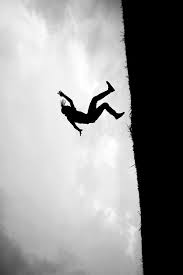Today marks Day 1 of a 2-week exploration of neurorehabilitation at The Kennedy Krieger Institute in Baltimore – one of the nation’s premier spinal cord rehabilitation centers. (Multiple sclerosis is, in case you’re wondering, considered a spinal cord injury).
Most people with my functional ability would be happy with the mobility they have, especially after living almost an entire adulthood with multiple sclerosis. I am not most people. I don’t want good function. I want to get back every shred of lost function… and also to be able to do press up handstands (which wasn’t something I could do… or tried to do… pre-MS).
At times, it’s hard to walk. There have been times where it has been harder than it is currently. There are also days where it is harder than other days. That’s pretty much the nature of MS.
Over the past several years, I have done hundreds of hours of work to try to strengthen and stretch the muscles surrounding my ankle to try to get my leg to work better. And I have maintained the function I recovered from when it was “worst” to “now.” Actually, it improved a lot, but it’s been about three years since things were at their worst, and about 2 years since things have been better and stable. I work almost every day to keep things at my current ability. But I want more improvement than I’ve been getting.
For those of you who have taken my course, you know that one of the most challenging things to work around is spasticity, and it’s my number one problem. Spasticity is abnormal muscle tone that’s common in neurological diseases. When one muscle is incredibly tight, it makes it nearly impossible for the opposing muscle to function correctly.
I came into Kennedy Krieger assuming I would see a lot of my friend, the goniometer. It reminds me of the protractor we used in geometry (my least favorite math subject ever!) and it’s used to measure range of motion of joints. It also measures how soon an active spasm kicks in to limit mobility.
To walk properly, you need about 10 degrees of dorsiflexion of your foot (meaning you can lift your foot up – toes towards your shin 10 degrees off of the floor). When I am lying down on my back, I have -25 degrees of active dorsiflexion (meaning how much I can make my foot move to my shin). So, I’m about 35 degrees from proper function. For me, the main reason for that immobility is that I have so much tightness in my calf muscles, my Achilles’ tendon, the fascia (we think), and there’s also probably some stuff going on with the joint capsule itself. I know from previous MRIs that I have chronic joint effusion (water on the ankle joint) and inflammation of the synovial sack (that makes that fluid). Whether those problems are from the improper movement or contributing to it is a mystery. Perhaps I’ll solve it this week.
First, my PT for the week, Kristen, strength tested all of my leg muscles (scores are from a 0-5, with 5 being perfect). My left leg dorsiflexors are a 3. Most other muscles are a 4 or a 5. I have spasticity in my left calf and quad (which I knew).
Next, we did a 6 minute walk to see how far I could go (1,360 steps). That’s pretty slow. The faster I walk, the more my calf tightens up, so you’ll never see me speed walking. Kristen noticed that my feet like to pronate (roll in) and that my dorsiflexion worsened over the course of the walk. I will say that today was/is a good walking day, so my leg wasn’t showing off it’s neurological issues as much as it could. Often my left leg will also hyperextend when I’m walking (that’s quadriceps spasticity), but that didn’t want to show itself today.
After the stroll, she strapped a belt around my waist that was attached to a computer to measure my gait – it measured pelvic stability (mine is pretty much perfect- thanks Pilates!), stride length, stance time, push off, etc. from one side to the other. My push off was much better on my right leg (stronger calf) and my stride length was longer on that side. When I added in my Walk-Aide (an electrical stimulation device that helps lift my foot into dorsiflexion at the exact right time during gait), I had a more even stride length AND I had a better push off of my left foot. This seemed weird because the device is stimulating the opposite muscle to the one that pushes off, but makes sense when you realize that the left foot has a better heel strike and opportunity to roll through the foot and use more of the force available in the plantar flexor (calves) to walk.
We did about 7 different walks- barefoot, shoes, shoes with orthotics, shoes with different orthotics, shoes without orthotics and with Walk-Aide, and shoes with orthotics and Walk-Aide. The last one yielded the most even gait, so makes sense for me to (continue to) incorporate in my gait training that I’ve been doing. Evidently, I also slightly posteriorly tilt my pelvis when I’m walking (probably to make it easier for my weak left hip flexor to lift my leg). In standing, my pelvis is slightly tilted the opposite direction (anteriorly).
So, we collected some data over a couple of hours. But the dilemma of the tightness remains.
Kristen introduced me to the Galileo, a vibration plate that is used for many neuromuscular issues, as well as to improve strength, balance, and bone density. The Galileo is actually the reason I wanted to come to Kennedy Krieger in the first place. I’ve tried a LOT of things for my left leg over the past decade. I have not tried this.
When people think vibration plates, what generally comes to mind is the Power Plate. They’ve pretty much cornered the market in fitness, but when you’re looking at neurorehab, the Galileo and its types and frequency of side-to-side oscillation have many more scientific studies backing them up. I’m not saying the Power Plate can’t be used for it or won’t work. I have no idea – never been on one. If you have – let me know!
After I used it (3 sets of 2 minutes – 1 standing, 1 standing doing squats, and 1 standing on my left leg only), we immediately measured my active dorsflexion, which had improved from -25 degrees to -18 degrees. Cool! The issue is that this change in spasticity is not shown to be a lasting change… BUT, the question is whether you can use that temporary improvement to work on exercises and stretches in a new, better range of motion that will ultimate improve mobility.
So, Kristen set our goal of getting my foot to an active 0 degrees of dorsiflexion by the end of the next two weeks. Which, honestly, is super ambitious and will be pretty unbelievable if we get there. Some of the things she wants to look at are splinting my leg at night (been there, done that), dry needling (done that, too), aquatic therapy (never tried that one), and joint capsule manual mobilization (haven’t done that one).
Tomorrow, I’m told I’ll have to do running, skipping, jumping tests. I can tell you in advance that I will suck at these. Did I ever mention I was a straight A student. Failure is not fun for me…
On that note, I forgot to mention that my proprioception is pretty much perfect. I do a lot of Pilates.
In health,
Mariska









